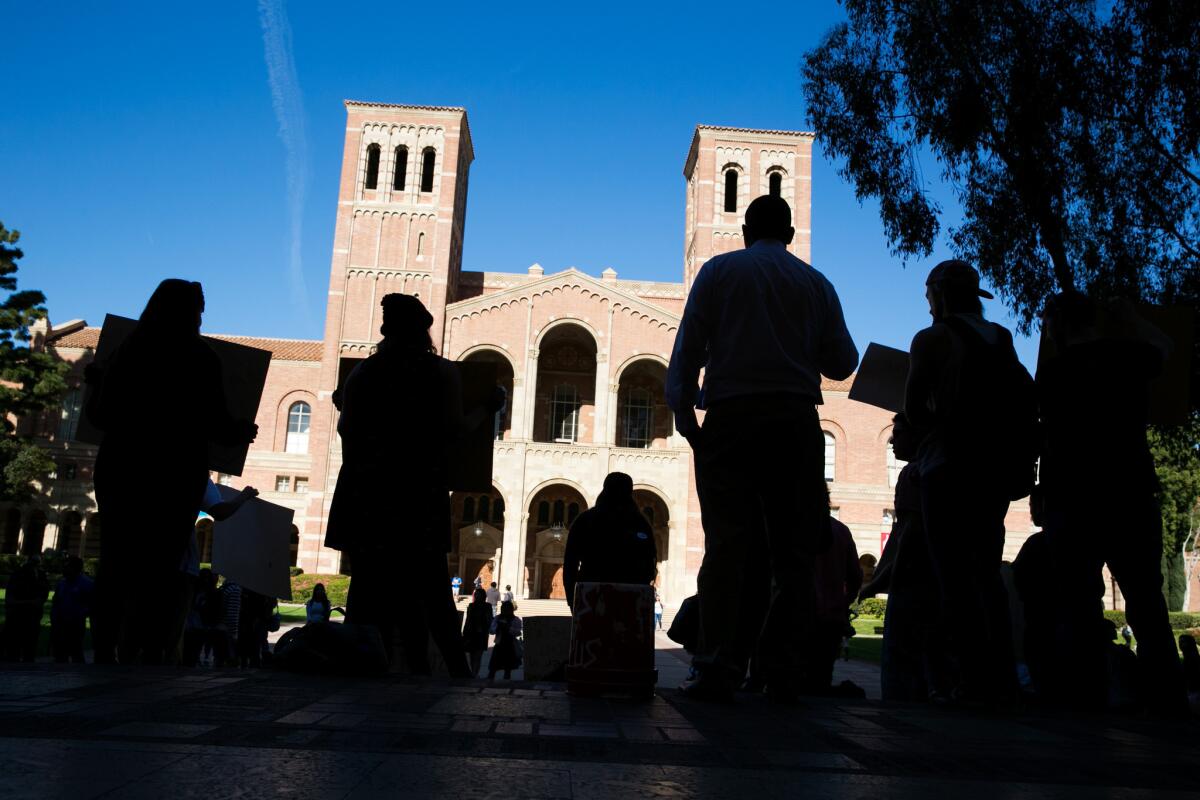Capitol Journal: Providing free college tuition in California is a good idea — but taxing millionaires to do it is a bad one

Reporting from In Sacramento — Kudos to Assemblywoman Susan Talamantes Eggman for boldly trying to free college students from paying tuition. That truly would make California “great again,” to plagiarize one Twitter addict.
Plaudits also to the Stockton Democrat for specifying precisely how she’d raise the $2 billion needed to finance the state’s largess. Unlike many of her lawmaking colleagues, she’s not just throwing out a big spending proposal and hoping the funds will somehow appear magically.
But hisses for selecting the money pot that she did: the million-dollar income earners.
Haven’t we in California been hitting these rich people enough? They’re everyone’s pigeons. When do they just bolt the state and leave a big hole in the Sacramento treasury?
Neighboring Nevada has no state income tax. Lake Tahoe, anyone? Or there’s tax-friendly Arizona. Its top income tax rate of 4.5% is the 13th lowest in the nation. Oregon has a 9.9% top income tax rate, but no sales tax. Washington state doesn’t have an income tax.
California’s soak-the-rich income tax rate is ridiculous: 13.3% at the top. California voters reauthorized that last November to help fund education, mainly K-12 schools. Because of those high rates, the top 1% of earners pay 48% of the state income tax, as of the last count in 2014.
That high tax rate includes a special 1% surcharge on all income above $1 million. This extra money goes to mental health care.
Now Eggman has introduced a bill to pile an additional 1% surcharge on those million-dollar earners, lifting the top rate to 14.3%.
The roughly $2 billion collected would cover all the California resident tuition costs not already being funded by various grants and financial assistance to lower- and middle-income students at the public universities.
“Everything has gone up, but middle-class wages haven’t kept pace,” Eggman says. “A middle-class income no longer affords a family the ability to send a child to college.”
Only a tiny fraction — four-tenths of 1% — of state income tax returns reported earnings exceeding $1 million in 2014. It amounted to 65,620 returns out of nearly 15.9 million.
These people are easy touches at the ballot box because they are so few. But their incomes also are unreliable, depending on whether we’re in boom times or bust.
Times now are good and the state expects that this year there’ll again be roughly 66,000 taxpayers with million-dollar incomes. But back during the recession in 2009, there were only 33,000.
So under Eggman’s bill, when the next recession hits, what would Sacramento politicians tell the college kids: “Sorry, we’re hurting. Better go borrow big”?
Then they’d likely be saddled with student loan repayments for many years, perhaps until their own children are headed to college. That’s the kind of stifling debt burden Eggman and other legislators are trying to end.
If free tuition is good public policy — and it certainly was for my generation — then the broad public should pay for it, not just a few rich people.
Eggman points out that since the tuition freebies would not be “means tested” — doled out based on financial need — wealthy students would also benefit.
That is, if they were attending the University of California or Cal State — not some private college such as USC or Loyola.
UC tuition currently is about $12,300 a year, plus campus fees. Cal State students pay nearly $5,500 plus fees. All told, these tuitions bring in about $5.9 billion a year. But the UC regents have voted to raise tuitions by 2.5%. And Cal State trustees, after heated debate, voted Wednesday to hike its tuitions by 5%.
I’ve heard some people argue — and had emailers write — that if tuition were free, there’d be less incentive for students to work hard and graduate in four years. College would be one big free party. Nonsense.
My generation paid no tuition at either UC or Cal State. But college was hardly free. There were room, board and book costs. Many of us still had to work part-time. For me, it was two years of live-at-home community college, two years away at San Jose State and graduation. Then off into the world. I couldn’t have afforded any more schooling.
California provided tuition-free college for generations. It helped California achieve greatness by broadening the middle class and offering opportunities for upward mobility not available in other states. It was an economic engine.
Gov. Pat Brown, Gov. Jerry Brown’s father, gets a lot of undeserved credit for creating this affordable, accessible college system through the Master Plan for Higher Education. Wrong.
Pat Brown was a great governor, but the tuition-less college system had been created many decades earlier and was continued through Republican governors and GOP-controlled legislatures. The master plan merely clarified the roles of the three higher-education systems.
Tuition reared its ugly head during the reign of Gov. Ronald Reagan amid violent anti-Vietnam War protests on university campuses. But the tuitions didn’t really soar until the 1990s as the state cut back on college funding. It had other obligations: escalating costs of healthcare, prisons and K-12 schools. The latter was the result of Proposition 13 property tax cuts that greatly reduced local funding for schools.
Eggman’s bill will require a two-thirds legislative vote and the governor’s signature to reach the 2018 ballot. That’s very iffy.
But if voters get a say, they might just enjoy socking it to the rich and restoring California’s greatness as a free tuition state.
Follow @LATimesSkelton on Twitter
ALSO
Here’s an idea for legislators: Figure out how to pay for a spending bill before proposing it
What does ‘sanctuary state’ actually mean? It’s time for lawmakers to figure it out
More to Read
Get the L.A. Times Politics newsletter
Deeply reported insights into legislation, politics and policy from Sacramento, Washington and beyond. In your inbox three times per week.
You may occasionally receive promotional content from the Los Angeles Times.











